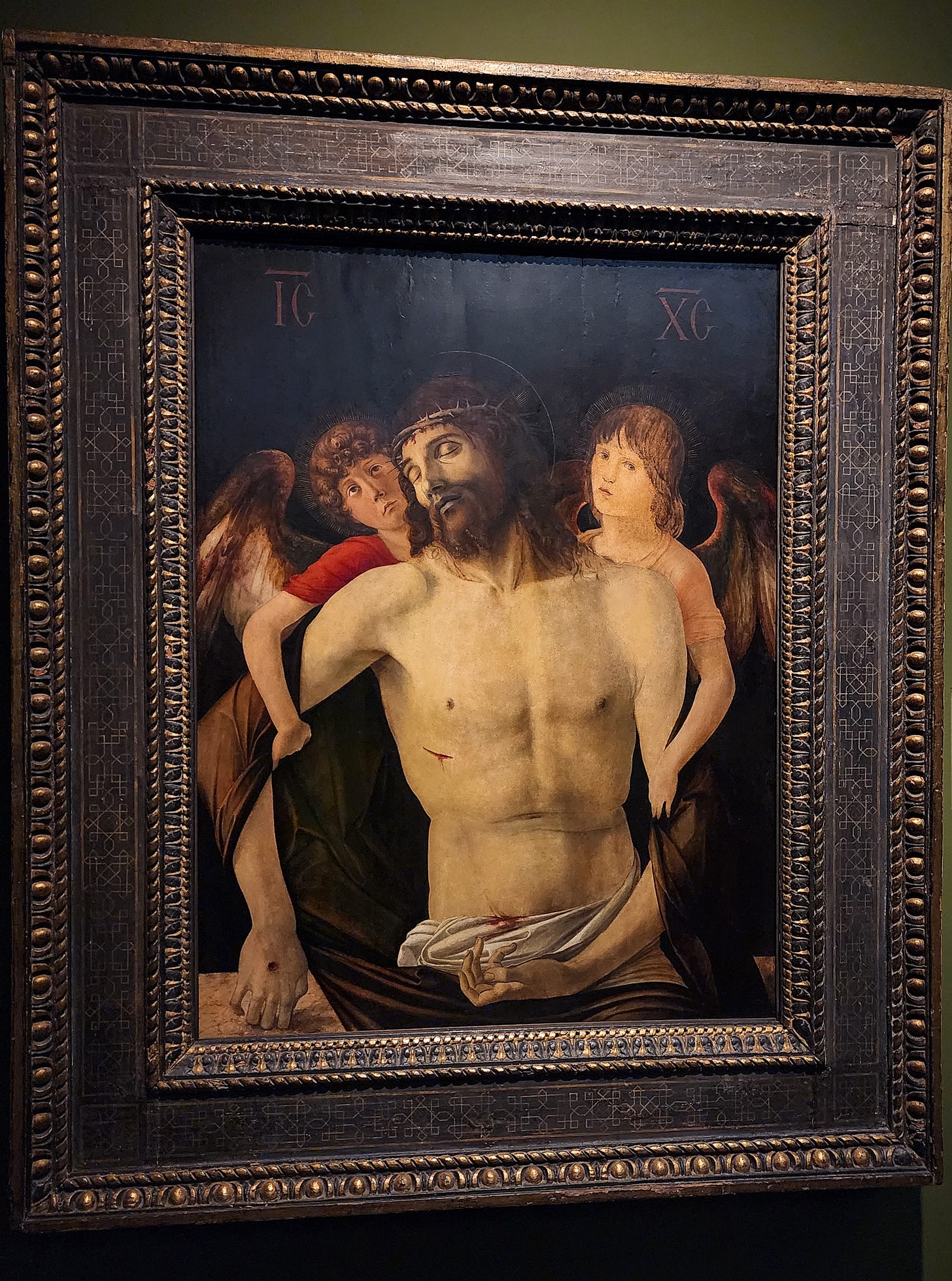A Holy Week Pilgrimage at the National Gallery: Saturday
Saturday was silent - we'll visit post-crucifixion events from Friday today
Immediately After Christ’s Death
Because Jewish law required burial before nightfall (Deuteronomy 21:23) and the Romans didn’t find this objectionable, Jesus was allowed to be taken down by Joseph of Arimathea, a follower of Jesus and a member of the elite classes, possibly even a member of the Sanhedrin. He was a good and just man and not at all in favor of their decision to put Jesus to death. He had gone to Pilate secretly but still courageously, fearing the Jews, and had gotten permission to take down Jesus’s body. This was a dangerous act as it could have been associated with Jesus’s alleged treason, risking his own execution. Pilate was shocked that Jesus was already dead and wanted it confirmed by a centurion before granting Joseph’s request, but eventually did so.
[Joseph must have had a ladder and He must have been very strong. Surely he had help. Matthew says Jesus’s body was given to him so perhaps Roman soldiers took the body down? But if it was Joseph which is what is explicated in Mark and Luke, then it was Joseph who at least took the lead in the entire process. Wow…the love it took for him to first go to Pilate, then to climb the ladder, then remove the spikes—how did he do that? Was there a special tool? Or tools? He must have been very strong—and then to carry Him down, that is a man who loved His Lord. But the more I think on this, I think the soldiers must have done it or helped in some way. What do you think? Also, The Deposition by Master of the Saint Bartholomew Altarpiece below, gives quite a dramatized interpretation of the event.]
Nicodemus, who had first come to Jesus at night, was also there when Joseph brought Jesus’s body down and had brought myrrh and aloes with which to bury him. This was a tremendously extravagant act for it is certain that these spices were the equivalent of thousands of dollars in our currency.
Then the two men wrapped Jesus in strips of linen with the spices. The body would have been tightly wrapped in long strips of linen, with spices layered between the cloths to honor the deceased and mask decomposition odors. They would have known how to wrap Jesus for burial due to their familiarity with Jewish burial customs, which were deeply rooted in the religious and cultural practices of first-century Judaism. As devout Jews—Nicodemus as a Pharisee and member of the Sanhedrin, and Joseph of Arimathea a wealthy and prominent figure and possibly also a Sanhedrin member—both would have been well-versed in these customs and had likely participated in or oversaw burials for family members or associates. (We do not know if they were assisted by others. But, oh my goodness, what if Jesus’s mother was one of those who helped prepare her Son for burial? Luke says the women came after, though, and that they saw the tomb where He had already been laid. Mark also says they observed where He was laid.)
In a nearby garden, not far from where Jesus was crucified, a new tomb, never used, sat ready. This is where they lay Jesus. It was a somewhat rushed affair because it was the Jews’ Preparation Day, the day before the Sabbath, which was also likely the first day of the Feast of Unleavened Bread, which followed Passover, a high Sabbath. This made it an especially significant day, as no work could be done on the Sabbath or a festival day, certainly not a burial. The Preparation Day was for completing tasks not allowed on the Sabbath, such as cooking, cleaning, etc. These tasks, including Jesus’s burial had to be completed before sunset to avoid violating Sabbath laws. The nearby tomb of Joseph’s, newly hewn from the rock, and never used, was very opportune as time to wash, anoint, and wrap Jesus’s body was very limited.
It looks like the Pharisees and chief priests went to Pilate the next day—on the SABBATH—to make sure that Pilate set a guard at Jesus’s tomb because they had heard Jesus say that He would rise again on the third day. They wanted to make sure Jesus’s disciples couldn’t come and steal Jesus away and then say He had risen from the dead. They received their guard and went to the tomb, secured it, sealed the stone, and set the guard to watch it.
Works at the National Gallery London
The events immediately following Christ’s death were by far the most prolifically represented at the Gallery during my quest. And, I see by some of the paintings that I am not the first person with questions about how Jesus was taken down from the Cross and how and who was present at His burial. I don’t think any of the following, though, are completely faithful to the Biblical accounts of what happened; much artistic license has been taken here.
The last painting, an unfinished Entombment by Michelangelo is a fascinating look into the great Master’s process. Extensive information is given by the Gallery website. It’s so interesting to me that he likely stopped working on this altarpiece in Rome because he was offered a great block of marble in Florence, from whence came His masterpiece, David (housed at La Accademia in Florence).
First, a Quick Glossary of Terms1 for Today’s Events:
Deposition (or, The Descent from the Cross): Jesus’s followers take His body down from the cross. Joseph of Arimathea and Nicodemus wrap it in linen with myrrh and aloe. Also present are the grief-stricken Virgin, John the Evangelist, and sometimes Mary Magdalen, other disciples, and angels.
Entombment: Jesus’s mother and friends place His body in a nearby sarcophagus, or rock tomb. This is done hastily because of the approaching Jewish Sabbath.
Lamentation (Pietà or Vesperbild): Jesus’s sorrowful followers gather around His body. An image of the Virgin mourning alone with Jesus across her lap is known as a pietà (from the Latin pietas, “pity”) or, in German, a Vesperbild.
The Man of Sorrows, probably by Jacobello del Bonomo (c.1385-1400). Egg tempera on wood.

“Images like this were made to provoke empathy for Christ’s suffering and death. He is shown after death, upright inside his open tomb, naked apart from a transparent loin cloth. His halo, which is now quite damaged, is encircled with rays; geometric shapes painted red, blue and green imitate gemstones. His hands cross in front of his concave stomach. Fat drops of blood drip from his hands and a slit-like wound in his side.
The droplets stand out from the picture surface – the artist sculpted them using gesso (a type of plaster), then painted over them. [I am fascinated to learn this.] He may have been inspired by sculptural representations of the Crucifixion known as crocefissi dolorosi (’sorrowful crucifixes‘). White highlights on the ribcage and collarbone make them appear protruded as they catch the light, emphasizing Christ’s emaciation. His eyes are closed; dark upturned crescents emphasise the heaviness of the lids. The image is a detailed study of physical pain and hardship.
This kind of image was known as the ’Imago Pietatis‘ (’image of pity‘) or the Man of Sorrows, and it is based upon an image from Byzantium, the Eastern Christian empire. Jacobello del Bonomo was from Venice, where Byzantine imagery was particularly common and popular. The Crusaders’ plunder of Constantinople (Byzantium’s capital) in 1204 and Venice’s trade links with the eastern Mediterranean meant there were plenty of precious Byzantine works of art to inspire Venetian artists.
Jacobello includes the Cross, painted in blue, behind Christ. The uppermost crossbar contains the damaged remains of a gilded inscription: INRI (the Greek abbreviation for ’Jesus of Nazareth, King of the Jews'). It is connected to the main part of the Cross with what looks like a narrow tree branch. This was supposed to remind worshippers of the Tree of Life, which represents eternal life, recalling the Tree of Life in the Garden of Eden, where humankind existed before sin. The message is that Christ’s Crucifixion and death caused the forgiveness of humanity.
Jacobello also includes angels with thuribles, perfume burners swung on chains, as a way of honouring Christ’s body. Their robes are not painted but rather patterned using a technique called stippling: the gold was stamped with lots of tiny dotted indentations. This created a dense texture that would have sparkled in candlelight. Close examination reveals that the angels are hovering above little clouds, now quite damaged, painted with expensive ultramarine paint.”2
The Dead Christ Mourned by Two Angels by Guercino (1617-1618). Oil on copper.

“This small painting depicts a solemn religious scene. Two angels kneel in quiet contemplation next to Christ, whose body has been taken down from the Cross following his crucifixion. While the Gospels make no mention of angels alongside the dead Christ, two are said to have been present at the tomb on the morning of the Resurrection. The painting possesses monumentality, despite its reduced scale, and its intensity of feeling makes it one of Guercino’s most poignant works.
Rather than depict the dramatic events of Christ’s crucifixion or resurrection, Guercino has created an imagined moment of grief and quiet reflection which evokes a powerful sense of sorrow. Naked but for the shroud which will envelop him in the tomb, Christ’s lifeless body anchors the lower half of the composition. He lies back, his head resting limply against a stone block. His face is turned away towards the angel in the centre, who looks intently at him. The other angel is overwhelmed with sadness, his eyes turned downwards and his head leaning mournfully on his hand.
Guercino has not emphasized the horror of the Crucifixion – Christ’s wounds are barely visible and his youthful body appears luminous against the foreboding sky. A halo glimmers around Christ’s head, a sign of his divinity, but his lifeless body is a reminder of his humanity as he leaves his mortal life behind.
This work was painted on copper, a material more expensive than canvas, and [thus painted at] reduced dimensions. They were primarily used for private devotion, and the subject of this painting, which encourages prayer and contemplation, reflects this. The copper support also gives the paint surface a fresh, textured quality – there are areas of thick impasto, such as in the highlights on the angels’ wings, where the artist’s brushwork stands out.
Painted around 1617–18, this work is characteristic of Guercino’s early style. The rich, earthy tones contribute to the soft but powerful contrast between light and shade. Although the overall colour palette is subdued, the vibrant red of the central angel’s robes stands out, as does the deep grey-blue placed next to the yellow ochre on the right – a colour combination typical of Guercino’s early works.”3
The Dead Christ Mourned (‘The Three Marys’) by Annibale Carracci. Oil on canvas.
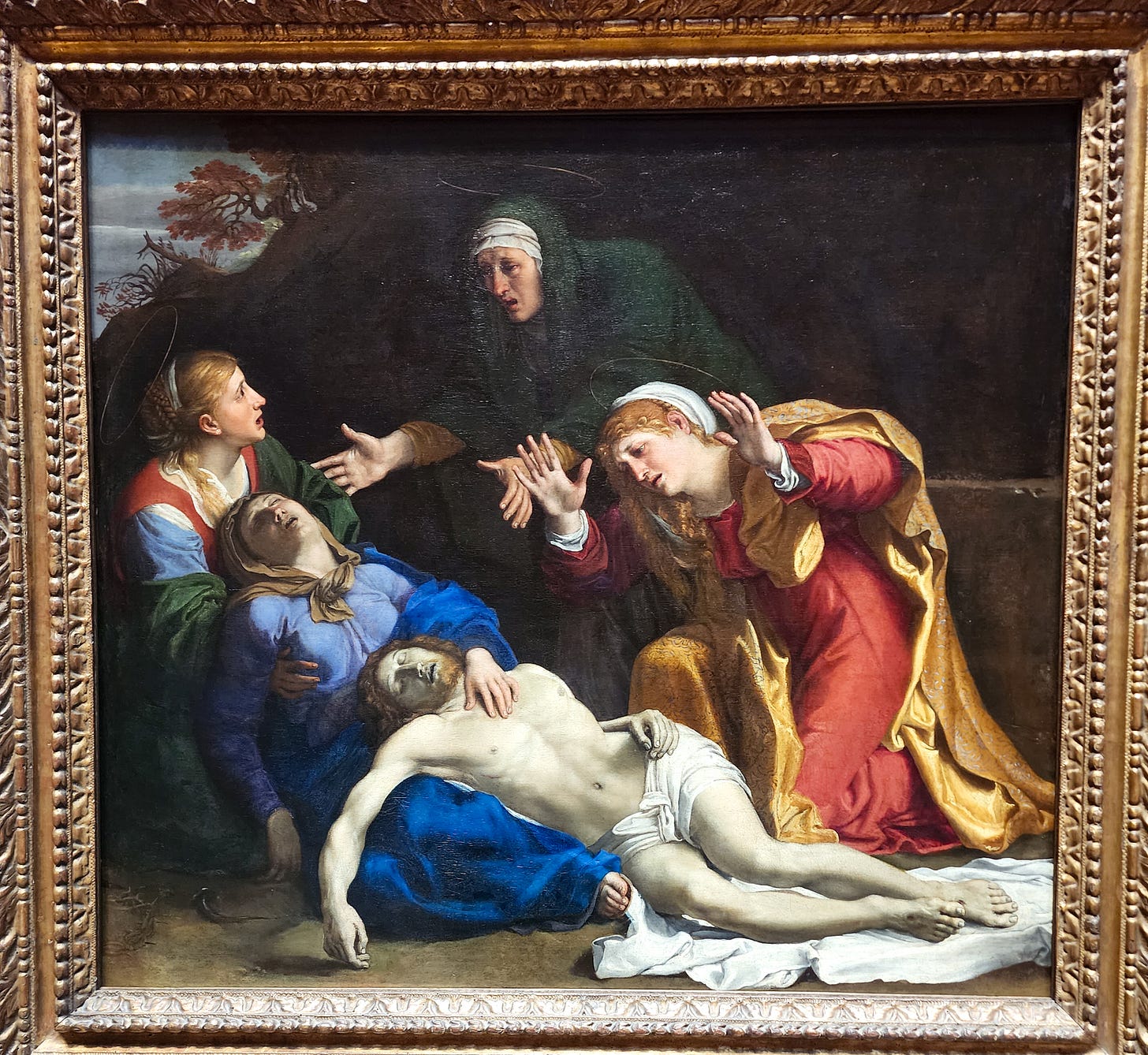
“This is perhaps the most poignant image in the National Gallery’s collection of the pietà – the lamentation over the dead Christ following his crucifixion – and one of the greatest expressions of grief in Baroque art. Christ’s limp and lifeless body lies in the lap of his mother, the Virgin Mary. A distraught Mary Magdalene, in her traditional red and with long fair hair, kneels on the right, hands raised and mouth open in a wail of anguish. At the back an older woman in dark green reaches out towards the fainting Virgin, whose weight is supported by a fair-haired young woman. Behind them looms a dark entrance to the stone tomb in which Christ will be buried.
The four Gospels all differ in their accounts of what happened after the Crucifixion, but the mourning for Christ by the women closest to him is not recounted in any of them. Conventional depictions of events following the Crucifixion tended to focus on the lamentation over the dead Christ, the Entombment, or the moment that the Three Marys discovered Christ’s empty tomb after the Resurrection. Annibale has compressed these episodes for maximum emotional impact. The identity of some of the women in the picture remains uncertain, but the trio at the tomb were said to have been the Virgin Mary, Mary Cleophas and Mary Salome, all of whom had also been present at the Crucifixion. The older woman in the background is perhaps Mary Cleophas, and the younger one on the left may be Mary Salome.
The composition is built on strong diagonals and our eye is guided around the picture by colour, gaze and expression. Christ’s limp and lifeless body is laid out in the foreground, the arrangement of his limbs echoed by those of his unconscious mother, linking them both structurally and emotionally. Her left hand – the only one in the picture to touch him – lies on his shoulder, and even his grey face, suggesting the onset of rigor mortis, is reflected by her deathly pallor. Our eye is led up Christ’s elongated torso to his mother’s face, and then the tones changes from cool blues to warmer flesh colours, the red bodice and golden hair of the girl supporting the Virgin. Her gaze, pointed towards the older woman, redirects ours. From this figure in half shadow our eye is drawn forwards and downwards to the bright clothing of Mary Magdalene, whose concentrated anguish is directed at Christ, bringing our attention back to him.
Annibale has skillfully concentrated our attention on each figure and her emotional response in turn. It [is a] brilliant combination of formal classicism with intense human sentiment.”4
Christ Carried to the Tomb by Sisto Badalocchio (c.1609). Oil on copper.
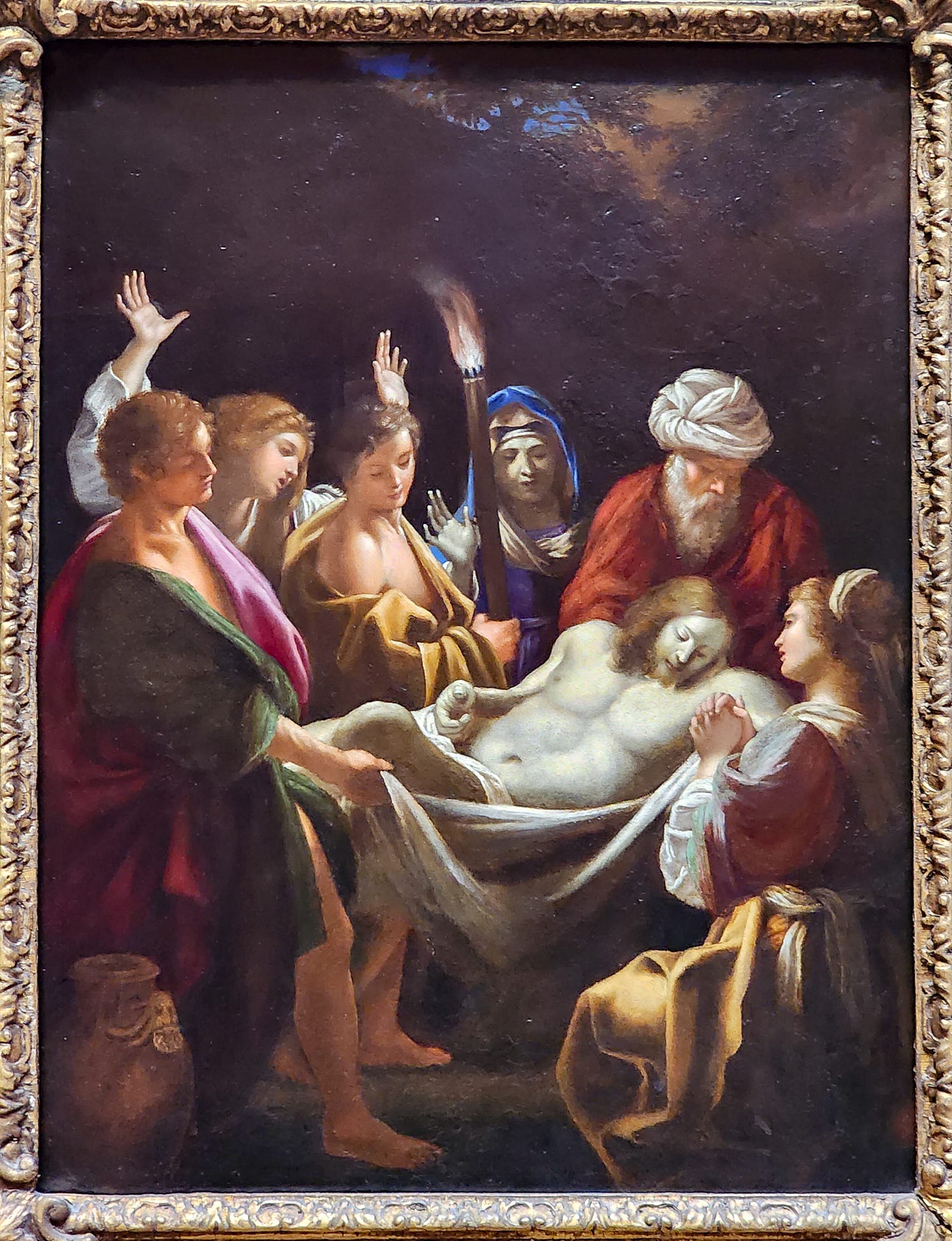
“Christ’s body has been taken down from the Cross and is being carried on a shroud to his place of burial. His head rests limply on his shoulder, his pale, foreshortened body the focus of a whole retinue of grieving figures, each expressing their sorrow in different ways. At the back is the Virgin Mary in blue; next to her in a turban is presumably Nicodemus or Saint Joseph of Arimathaea. The kneeling women on the right is perhaps Saint Mary Magdalene and one of the young men might be Saint John the Evangelist. Although not described in the Gospels, this variant on the Entombment was occasionally depicted in Renaissance and Baroque art. An example by Michelangelo is also in our collection: The Entombment.
Despite the small scale of this picture, the composition is monumentally conceived and the scene is imbued with a deep sense of pathos. It is painted on copper and the artist has exploited the material’s reflective properties by painting a night scene, contrasting the darkness of the cave with the flickering light of the flaming torch falling on the figures. The figures are placed centrally and close to the picture plane, increasing the viewer’s emotional involvement: we feel we are there, among Christ’s family and friends, sharing in their grief.”5
Lamentation Over the Dead Christ by Jusepe de Ribera (c. early 1620s) Oil on canvas.
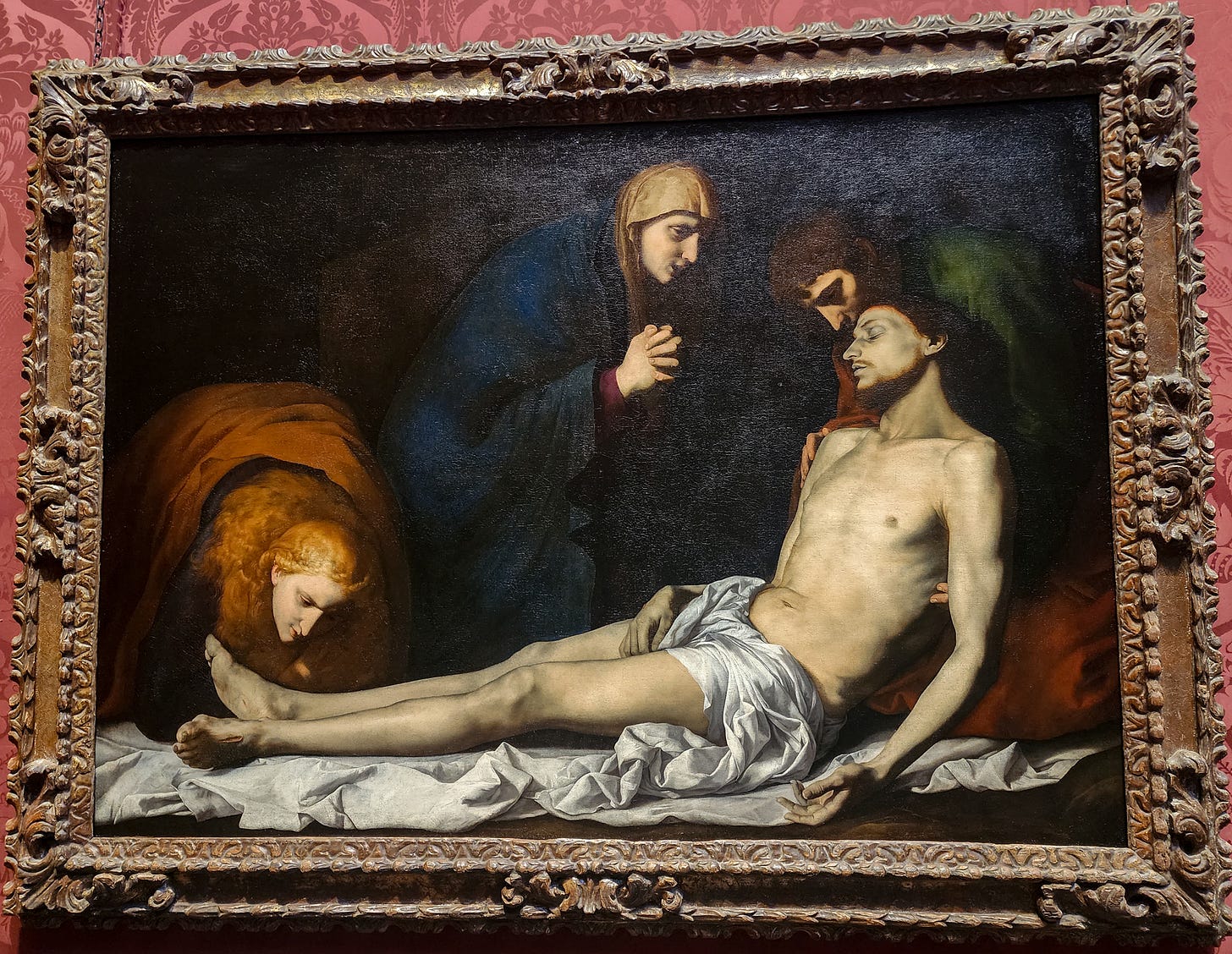
“Ribera captures the moment when Christ’s lifeless body is laid out after it has been brought down from the Cross. A solemn Saint John the Evangelist, dressed in red and green, gently supports Christ’s elegant corpse. Christ’s pallor is striking – his lips and skin are turning grey-blue – and his body seems to radiate light, as does the white sheet beneath him. Christ’s hands and feet bear the wounds he suffered by being nailed to the Cross and his brow is smeared with the blood he shed from wearing the crown of thorns, a symbol of Christ’s Passion. Recent cleaning of the picture revealed the crown just behind Christ’s right forearm (barely visible except in good light) and some masonry behind the figures, intended to represent the tomb in which Christ’s body will shortly be laid to rest. In the centre, in blue, is the Virgin Mary, who joins her hands in prayer and looks down at her son in extreme sorrow – a tear is rolling out of her right eye. The young woman bent over Christ’s legs is Mary Magdalene: she brings her face close to Christ’s feet, as if about to kiss his wounds. Her golden tresses cascade over her back evoking the biblical passage in which she used them to wipe Christ’s feet in the house of Simon (Luke 7: 36–8). The scene is one of extreme pathos, enhanced by the sombre atmosphere and dramatic lighting.
Caravaggio, whose works Ribera had had the opportunity to study in both Rome and Naples, [had] a lasting influence on Ribera: here, the forceful chiaroscuro and naturalistic rendering of the body of Christ – surely modelled on a real person – are both inspired by him…[There is] dramatic illuminat[ion] and Christ and the other figures are spot-lit against an almost pitch-black background.
Technical examination of this painting, including X-radiography, has revealed that Ribera originally painted Mary Magdalene’s face much closer to Christ’s right foot, in the act of kissing it. It is not clear why Ribera changed his mind here, but he may have preferred not to have anything interfere with the pure outline of Christ’s body.”6
Lamentation by Gerard David (c. 1515-1523). Oil on oak.
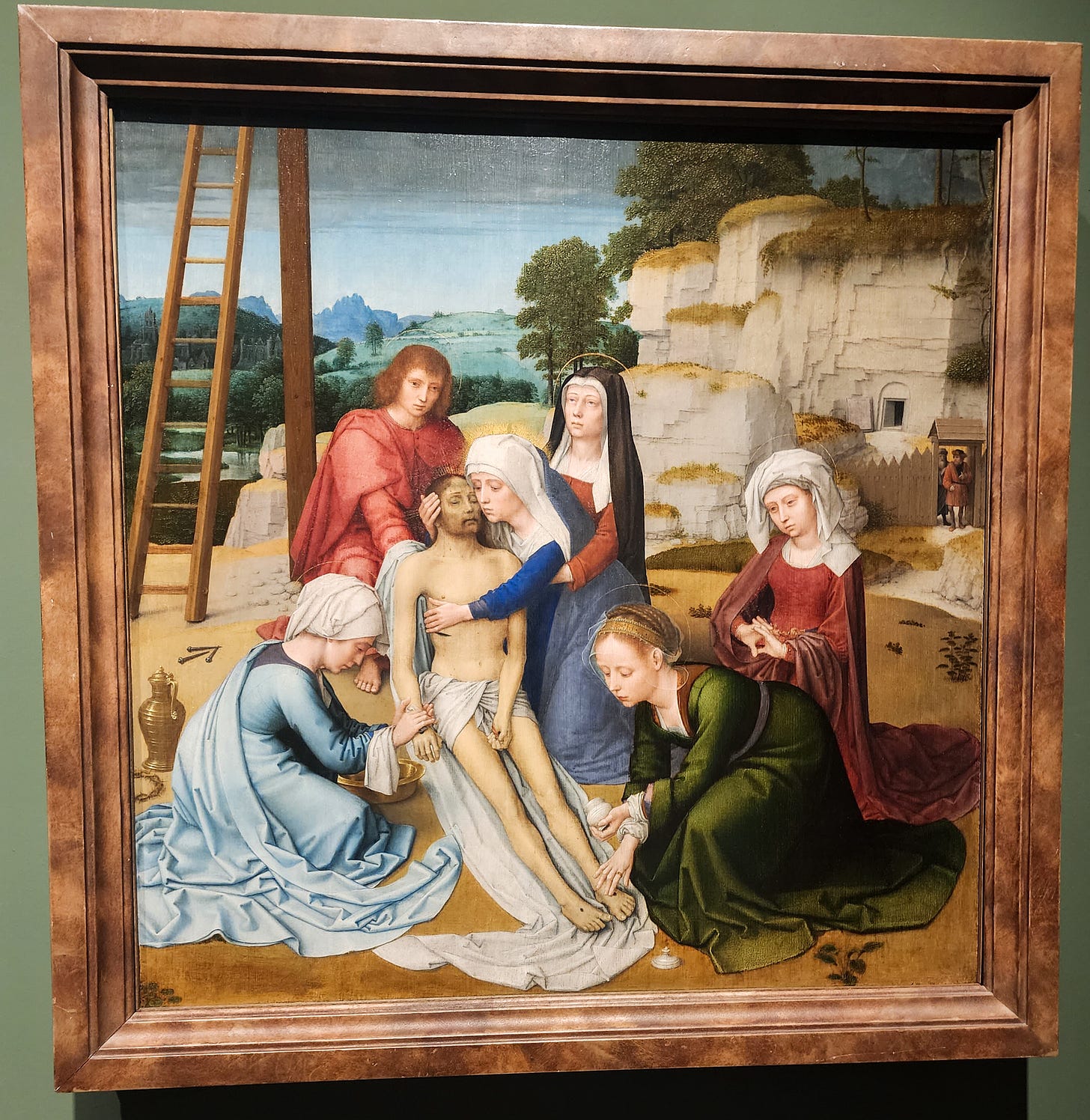
“Christ’s body has just been brought down from the Cross and is being prepared for burial. The three large nails removed from his hands and feet lie below the ladder, and the crown of thorns is below the jug on the left. Saint John the Evangelist supports the body on its shroud, and the Virgin Mary embraces her son tenderly. On the right, Mary Magdalene anoints Christ’s feet with ointment from a small pot – her attribute. She is also identified by the inscription on her headdress (‘M.A.M.A’, standing for Maria Magdalena), and her action, recalling how she previously anointed his feet at Bethany.
Another woman washes Christ’s wounds with water from a brass basin, a second supports the Virgin and a third looks on sadly. The men entering through a gate on the right are the two secret Jewish converts to Christianity: Nicodemus, who brought spices to embalm Christ’s body, and Joseph of Arimathea, who gained permission to bury him after the Crucifixion. According to the Gospel of John, Christ was crucified in a garden in which there was an unused tomb – presumably the area fenced in by wooden palings here, with the open door of a rock tomb beyond.
The Lamentation is not included in the biblical account of the Crucifixion, but was found in the apocryphal gospels and described in detail in medieval devotional literature. It became very popular in northern European art in the later Middle Ages.”7
The Deposition by Master of the Saint Bartholomew Altarpiece (c. 1500-05). Oil on oak.
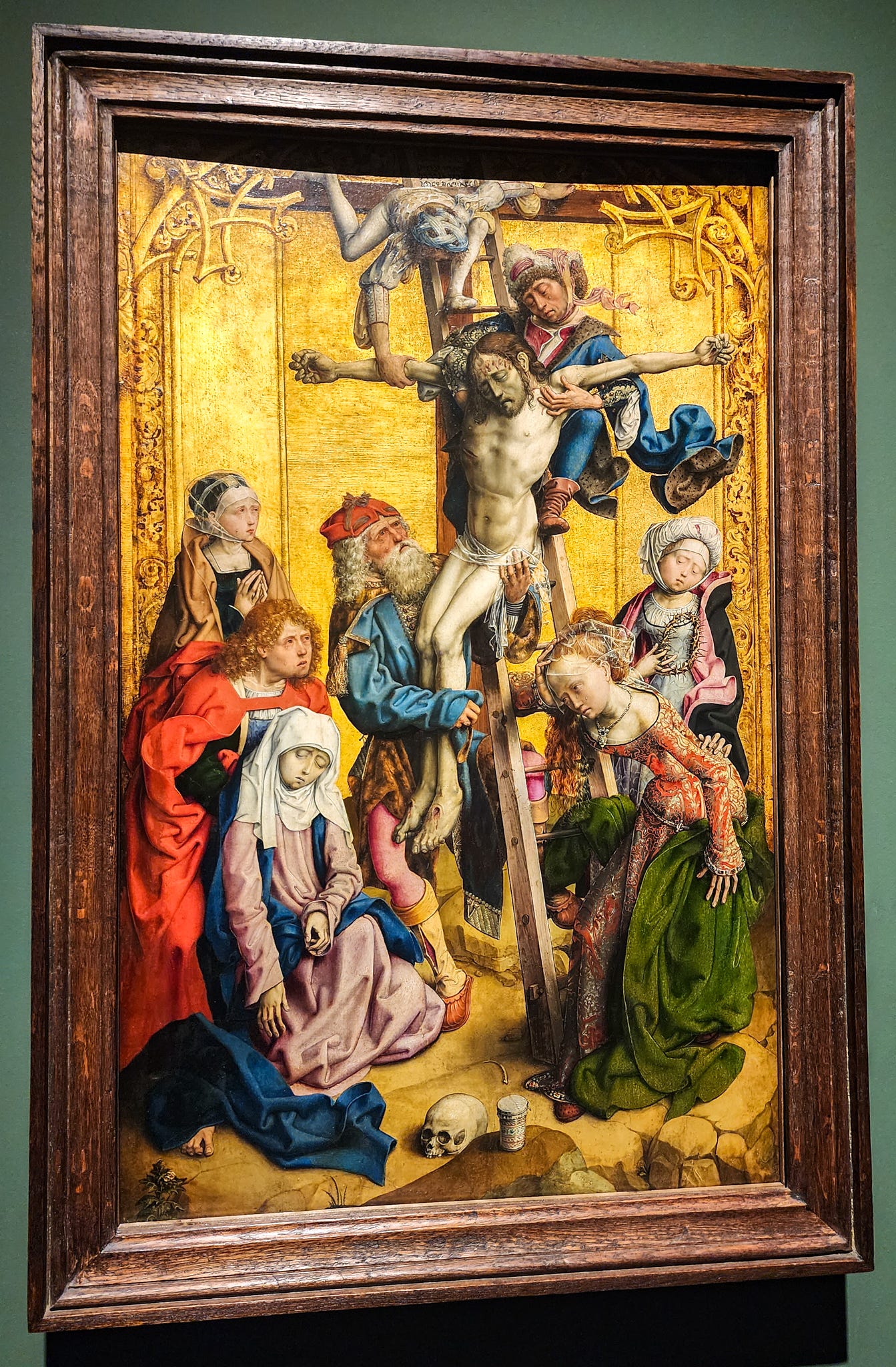
“The removal of Christ’s body from the Cross takes place in what appears to be a shallow gilded niche. The solid background offers no respite from the horror of Christ’s pale and emaciated dead body, his bloodied forehead and wounds, and the intense grief of his family and companions. The setting, with its stiff geometric decoration around the arch, may be intended to resemble contemporary carved tabernacles, which included this kind of elaborate tracery and contained sculpted figures within.
The effort required to manipulate a body stiff with rigor mortis is emphasised by the awkwardness of the poses of the two men on the ladder. A nimble boy at the very top attempts to support Christ’s weight while clinging on to the arm of the Cross, hooking one ankle over it to prevent himself from falling headlong. Joseph of Arimathea, who had offered up his family tomb for Christ, supports his upper body; the movement of his cloak, which unfurls in an improbable cascade, expresses the energy of the feat. Christ’s corpse is finally gathered by Nicodemus, the elderly Pharisee, who, according to the Gospels, believed that Christ was the Son of God.
The mourners are shown weeping, the teardrops glistening on their cheeks. The Virgin Mary’s knees have given way beneath her and she is slumped on the ground, supported by Saint John the Evangelist, the figure with wild hair in the red cloak. Mary Magdalene clasps a tense, bony hand to her head in shock and grief. She too is barely able to stand. Her attribute – a pot of ointment with which she anointed Christ’s feet in recognition of his divinity (Luke 7: 36–50; John 12: 1–8) – is at the foot of the Cross. The episode was regarded as foretelling Christ’s death, as ointment was also used for corpses. A skull lies next to it, a reminder that the place where Christ was crucified was called Golgotha, meaning the place of the skull; this was where, according to tradition, Adam was buried. Christ, known as the second Adam, had come to redeem mankind from Adam’s sin through his resurrection.
Viewers of this panel, which was probably made for use in private worship (though we cannot be sure), would have been certain of Christ’s resurrection even though this intense painting presents an unflinching depiction of the horror and sorrow of his death.”8
The Trinity and Mystic Pietà by Hans Baldung Grien (c.1512). Oil on oak.
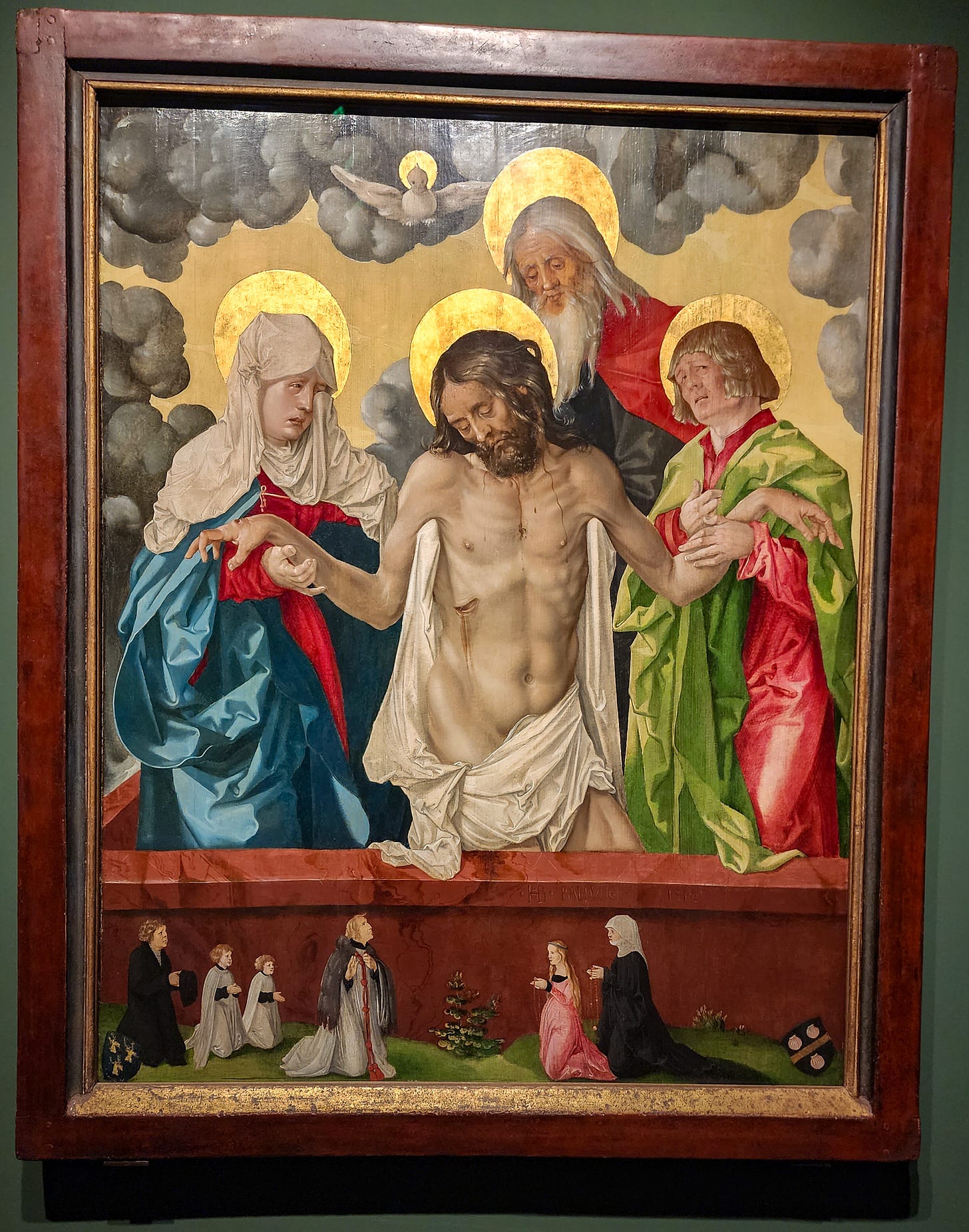
“The Virgin Mary and Saint John the Evangelist stand with Christ in his red marble tomb supporting his lifeless body. He is partially covered by a burial shroud, but the spear wound on his side is visible. Streaks of blood on his chest have run down from the cuts on his forehead caused by the crown of thorns.
The Virgin’s face is contorted with grief as she wipes her tears with her white veil. John places his hand to his breast, an agonised expression on his face. All three members of the Trinity are present: behind Christ is God the Father, also shown grieving, like a human parent; above him is the dove that represents the Holy Ghost. The divine figures occupy a heavenly realm; the yellow-gold sky seems to have dispelled the dense storm clouds, which have scattered to the edges of the scene.
The small figures in front of the tomb are probably the painting’s patrons, their size emphasising both their own humanity and the divinity of the group they worship. Women kneel on one side and men on the other, their hands pressed together in prayer. They are being led by the figure at the centre dressed as a canon, who raises his right hand and looks up towards Christ, creating a connection between the patrons and the holy figures. The patrons cast shadows on the grass beneath them, a detail that Baldung Grien included to emphasize their physical presence in contrast to the heavenly vision they are witnessing.”9
The Lamentation Over the Body of Christ by Dosso Dossi (c. 1517-18). Oil on wood.
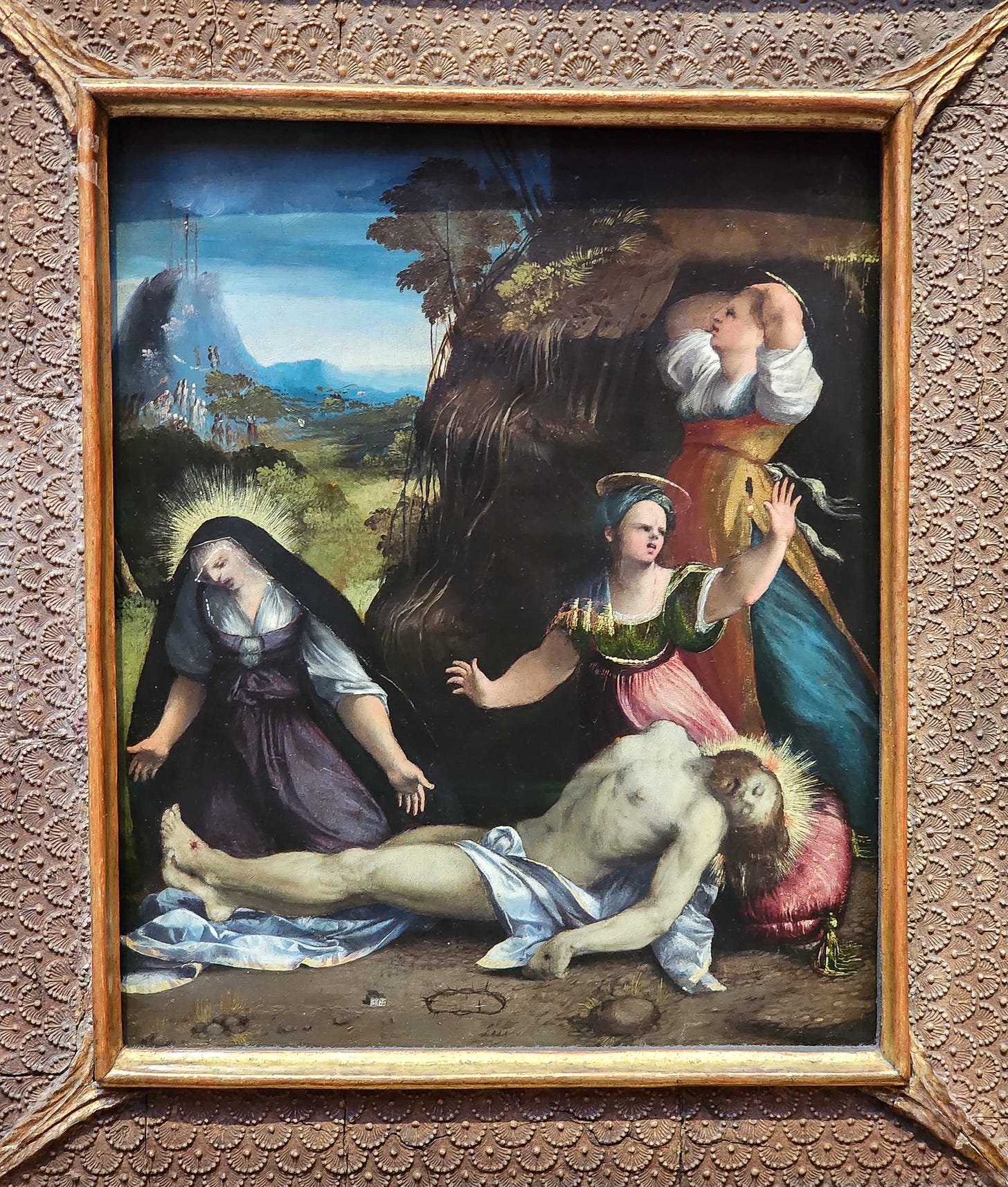
“The Three Marys mourn Christ following his crucifixion. The Virgin Mary kneels at Christ’s feet, her outstretched arms framed by her dark mantle. A halo of golden rays of light emanates from her covered head. It is unusual for the Virgin to be shown at Christ’s feet; normally his body is laid across her lap. Christ’s head is haloed by similar rays, although he also has four sets of red rays among them, which show that he is one of the Trinity.
Mary Magdalene kneels by Christ’s head, her arms raised as though gesturing to someone outside the picture, perhaps another mourner. Mary Cleophas stands behind her clutching her head and tearing her hair with grief. All the woman have powerful expressive limbs and intense, anguished expressions. The demonstrative gestures, distorted anatomy and colour contrasts are typical of Dosso’s early work, but here they are taken to extraordinary heights.
Christ’s feet remain crossed, as they were when nailed to the Cross. A wound from a nail can also be seen in his hand. His chest is arched and his head collapsed, as though his body has stiffened in death; its grey colour contrasts with the pink flesh tones of the other, living, figures. His back seems to be resting on the large pink cushion behind his head, although the size of the cushion is unclear as it is the same colour as Mary Magdalene’s skirt.
Calvary, the hill where Christ was crucified, can be seen on the left in the distance. Three crosses stand on its summit against the sky. The one on the left seems to have been occupied by Christ as it looks as though it bears the traditional scroll inscribed ‘I.N.R.I.’, meaning ‘Jesus of Nazareth, King of the Jews’. It is unusual for Christ’s cross not to be in the middle. The bodies of the two thieves still hang on the other crosses. The background of the picture is painted very freely, which is especially noticeable in the rocket-like brushstrokes intended to represent crowds of figures at the base of the hill – a remarkable example of Dosso’s dramatic handling of paint.
The crown of thorns, with which Christ was humiliated during the Passion, lies on the ground beside him; beside it are the dice thrown by the soldiers who gambled for his clothes. It is very uncommon for the dice to be included in a painting of the Lamentation.
Although the distortions of expressions, forms and space in the picture are particularly strange, they and the manner in which it is painted are highly characteristic of Dosso – especially the jagged white lights on the crisp papery folds of Christ’s loin cloth, the flickering yellow and pink brushstrokes of its border ornament and of the tassels of the cushion under Christ’s head and the alternating, almost vertical, strokes of strongly contrasting deep plum and light pink showing the pleats of Mary Magdalene’s dress.”10
The Lamentation Over the Dead Christ by Francesco Francia (c. 1515-16). Oil on wood.

“The Lamentation is described in the apocryphal Gospel of Nicodemus. Here, Christ’s crucified body is laid down outside the cave in which he will be entombed. The identity of the figures mourning Christ is not certain. Nicodemus or Saint Joseph of Arimathea kneels on the left with his hands clasped in prayer while Saint John the Evangelist, in red and green, supports the body of the dead Christ. The Virgin Mary stands in a gesture of sorrow and Mary Magdalene supports Christ’s feet. A veiled woman appears on the right, probably intended to be Mary Cleophas. She is now only partly visible as the right edge of the painting has been cut down.
Francia has devoted particular attention to the depiction of minute details, such as the figures' eyes, which are red with weeping, and the wounds on Christ’s forehead caused by the crown of thorns. The highlights on hair, especially on the loose rippling locks of Mary Magdalene, are painted with great delicacy. The figures are placed in an almost symmetrical arrangement, with the standing Virgin forming the apex of a broad-based triangle, giving the scene a sense of gravity and stillness. Saint John’s head echoes the angle of Christ’s, and Mary Magdalene’s echoes that of the Virgin; this repetition creates a sense of restrained but shared grief.
The landscape, which meets the pale horizon at the blue hills, is especially atmospheric: the towers of a distant ghostly city rise among bushes and wooded hills while the leaves of a sapling are outlined against the sky. A sense of depth is created by aerial perspective – the way in which colours appear to change with distance when seen through the air.”11
The Entombment of Christ by El Greco (early 1570s). Oil on panel.
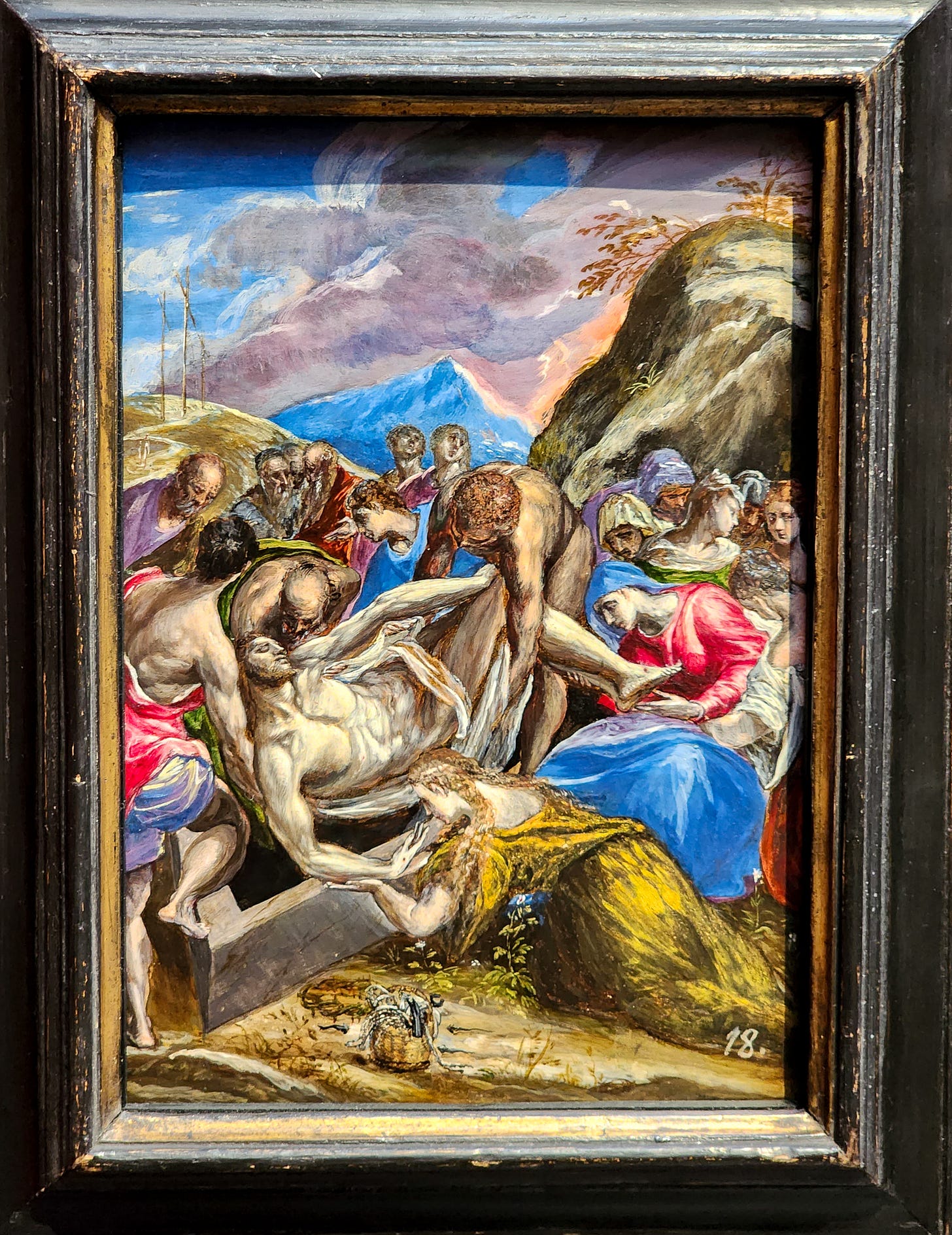
Unfortunately, the loan period for this painting ended in 2024 and I can find little information other than that from the information card above. But I’m so glad we get to see it at all!
The Dead Christ Supported by Two Angels by Giovanni Bellini (1465-70). Oil on wood.

“Giovanni Bellini returned to the subject of the dead Christ many times over the course of his career. This type of image of Christ after his death – close up, showing his naked torso – was sometimes known as the ‘Imago Pietatis’ (‘image of pity’). It originated in Byzantium but was very popular in Italy from about the thirteenth century, and was supposed to promote meditation upon Christ’s suffering and death.
Bellini maintained the focus on the torso and wounds but experimented with differing backgrounds and positions for Christ’s arms, which were traditionally shown crossed in front of him. Here Christ is supported by two angels who hold his arms to prop him upright. The resulting pose is appropriately awkward and unnatural; it highlights the weight and inertia of his dead body but also its physicality – it is thrust towards us, challenging us to contemplate it. This stark confrontation is emphasised by the dark background and the strong lighting.
The depiction of Christ’s body we see in this image shows [the sculptor Donnatello’s influence]. Donatello was deeply interested in classical sculpture and his works often showed idealised bodies. Although Bellini’s Christ is thin, his torso and shoulders are broad and his body resembles a statue of a pagan god more than a corpse. Although his lips are a bloodless grey and there are dark circles beneath his eyes, his facial features have classical forms and proportions.
This is one of Bellini’s earliest pictures where he used oil – analysis has identified walnut oil – to bind his pigments. Working with oil requires a different technique to working in tempera (pigment bound with egg). Although this is one of his first experiments with oil, he used it to create different effects – the stroke of white paint under Christ’s left eye is painted quite broadly, whereas incredibly fine strokes define individual hairs in his beard. This is quite different from the minute and carefully applied brushstrokes Bellini used in his tempera paintings.”12
The Entombment (or Christ Being Carried to His Tomb) Michelangelo (1500-1). Oil on wood.

“This unfinished painting shows Christ’s body being carried to his tomb in the rocks behind him. It is one of only three known surviving panel paintings by the great Florentine artist Michelangelo.
In 1500 Michelangelo was commissioned to paint an altarpiece for the funerary chapel of Giovanni da Viterbo, the deceased bishop of Crotone, in the church of S. Agostino, Rome. Although the subject of the altarpiece is not documented, it is likely that this was the commissioned painting. The chapel was dedicated to the pietà, and the Entombment would have been an appropriate subject. The lighting in Michelangelo’s painting is from the left, which accords with the natural lighting of the chapel, and the picture’s measurements would have fitted the width of the chapel bays.
However, the altarpiece was left unfinished when Michelangelo returned to Florence the following year, probably to procure for himself the great block of marble being offered by the authorities of Florence Cathedral, intended for a statue of David – a statue for which he signed the contract in August 1501 and which he would complete in 1504 to his everlasting fame (Accademia, Florence). He would not return to Rome until 1506 and returned the advance payment for the altarpiece to the friars of S. Agostino when he failed to deliver it.
There is some disagreement over the identity of the various figures in the painting. Saint John the Evangelist is usually shown in red with long hair, and may be the figure on the left carrying Christ. The woman who strains with Saint John to carry Christ’s body on the strips of winding cloth in which it will eventually be bound is one of the Three Marys, probably Mary Cleophas, who looked after Christ at the end of his life. They carry him up a staircase to his tomb.
The man who lifts Christ from behind is either Joseph of Arimathea, who donated his own burial place for Christ, or Nicodemus, who helped lower Christ’s body from the Cross and prepare it for burial. Another of the Three Marys, possibly Mary Magdalene, sits on the ground. A drawing for this figure (Louvre, Paris) shows that she was intended to be gazing sorrowfully at the crown of thorns and the nails with which Christ had been crucified.
The space left empty on the right was probably intended for the kneeling figure of the Virgin Mary. Michelangelo would have needed ultramarine blue made from the semi-precious stone lapis lazuli to complete the missing figure of the Virgin, as her mantle is traditionally painted this colour. The requisite ultramarine is also missing from Michelangelo’s unfinished Manchester Madonna. It may be that he was waiting until the last moment before adding this colour as it was the most expensive pigment and possibly difficult to obtain. A late seventeenth- or early eighteenth-century drawing, made of the painting when it was less worn (Biblioteca Comunale degli Intronati, Siena), indicates that the Virgin was to be shown kneeling with her back to the viewer, probably with hands joined in prayer, gazing at the corpse of her son. The other female figure on the right is another of the Three Marys, perhaps Mary Salome.
The Entombment reflects Michelangelo’s belief that painting is better the closer it is to sculpture. The picture is almost a high relief sculpture transposed into paint – the figures are arranged in a bold rhythmic composition and there is little space between them. The focus is on the naked body of Christ, which is shown as perfect and beautiful – God made into man (curiously, Michelangelo never painted his genitals). The twisting movements and defined muscles of Michelangelo’s figures are based on his direct observation and drawing of live models.
More traditional depictions of the Entombment show Christ’s body carried horizontally, but Michelangelo shows it lifted vertically and held up to the viewer as if it were the Eucharist. This arrangement is similar to that used by Fra Angelico in his The Dead Christ before the Tomb of about 1438–40, from the predella of the high altarpiece in S. Marco in Florence. The church was only a few steps from the sculpture garden at S. Marco where Michelangelo learnt to sculpt. This vertical pose also appears in The Dead Christ before the Tomb (now in Badia a Settimo) by the workshop of Domenico Ghirlandaio, where the young Michelangelo trained as a painter.
If Michaelangelo’s painting had been installed as an altarpiece, the priest would have stood in front of it and lifted up the sacrament – the bread – during the Eucharist, so it became the body of Christ silhouetted against his perfect painted body. Christ’s upright position also seems to allude to his imminent resurrection. The startlingly nude body is weightless and pristine with no sign of suffering, perhaps referring to the immaculate resurrected and heavenly body described in the First Epistle to the Corinthians (15: 35–49). In this way the picture is both devotional, inviting Eucharistic contemplation of the dead Christ, and narrative, showing his body being removed from our sight – in a few minutes he will be gone.
Like the also unfinished Manchester Madonna, The Entombment offers a fascinating insight into Michelangelo’s working methods. While the Manchester Madonna is painted in egg tempera on panel, this picture is painted in oils, revealing Michelangelo’s unusual approach to the medium. Michelangelo painted each figure in full before moving on to the next, as though he were painting in tempera, a technique that he had learned in Ghirlandaio’s studio. As in the Manchester Madonna, some colour areas were left entirely untouched whereas others are near to completion. This approach is not often seen in oil painting of this date in Italy – for example, in oil paintings left unfinished by Raphael, we find the whole composition worked up evenly and each colour area left in a similar state of incompleteness.
Instead of creating relief by building up transparent glazes over an opaque underlayer of paint, as was the oil painting technique used in Venice and the Netherlands, Michelangelo modelled his forms by blending his shades into one another while they were still wet. As with his tempera technique, which also creates an opaque effect, Michelangelo added white to create a tonal range and used glazes only for the deepest shadows or specific colour effects.
At the top right he scraped away the dark paint of the rock to suggest the two figures moving back the stone that closes the tomb, removing material just as he did when sculpting in marble.”13
Today’s Scripture Readings:
Matthew 27:57-66
Mark 15:42-47
Luke 23:50-56
John 19:31-42
Marilyn Stokstad, Art History (Upper Saddle River, NJ: Prentice Hall, 1995), page 307. “Iconography of the Life of Jesus”
*Notes from the information card adjacent to the painting
Photos of the above National Gallery paintings ©Renate Flynn.




